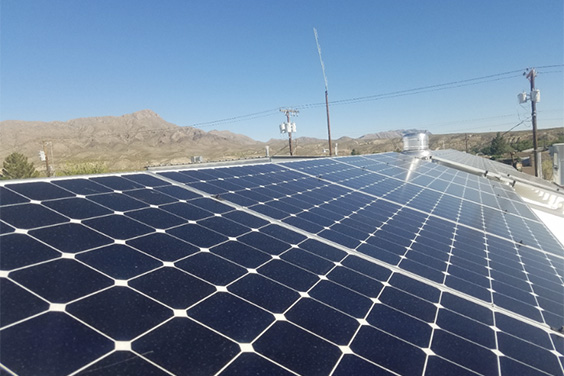LOS ALAMOS COUNTY
Los Alamos County Department of Public Utilities on its goal to become a carbon neutral electric provider by 2040.
Los Alamos, New Mexico (LAC) is a unique community. One unique aspect of our small, rural town is that while our County has a population of approximately 18,000 people, its municipal-owned Department of Public Utilities (DPU) is a power producer. We supply over 600 gigawatt hours of electricity to the Los Alamos National Laboratory (LANL) and the county per year with owned resources, contracts, and purchases. Approximately 30 percent of our portfolio includes renewable energy generation resources. Twenty-seven megawatts of renewable energy generating capacity comes from the county-owned hydroelectric facilities and a utility-scale solar array located on a decommissioned landfill. The remainder of the portfolio is a coal-fired electric generation.
Feedback from our customers, the citizens of Los Alamos County, indicates clean energy is important to our community. Various surveys revealed that almost 70 percent of our customers were willing to pay more on their electric bills for renewable energy. Accordingly, on September 18, 2013, the Los Alamos Board of Public Utilities (BPU), the governing authority of the DPU, adopted a broad goal of being a "carbon neutral electric provider by 2040." Adoption of this goal by the BPU was in direct response to its customers, and to migrate away from carbon-producing energy sources.
What tools, resources or financing did you use to establish your project?
On February 17, 2015, the BPU commissioned a citizen board, The Future Energy Resource Committee, to define carbon neutrality, to help frame the discussion about what the goal meant, how to achieve the goal in a systematic, organized, and cost-effective fashion, and to make recommendations that would assist the DPU toward this goal. The committee’s charter was "...to examine and recommend clean energy generation resources, and study and recommend policy toward distributed generation in the County." A report of the FER Committee’s findings and recommendation was issued on July 7, 2015.
In addition to the above, our citizen committee’s report also assessed the county’s carbon footprint, its relationship with LANL and potential load changes. Current and future generation resources, opportunities and risks associated with the regulatory environment were also investigated, as well as an in-depth analysis of distributed generation or rooftop solar. Conclusions of the report proposed a definition for the term carbon neutral and introduced lengthy recommendations that revolved around resources and near-term actions, policies to advance the carbon neutral goal, and rate structures.
After several meetings, the BPU adopted a definition of carbon neutrality and adopted almost all the recommendations within the FER Committee report. The BPU directed the DPU to develop a schedule to research and review all the adopted recommendations.
The BPU adopted a definition of carbon neutral as they pursue the goal “to be a carbon neutral electric provider by 2040.” The definition is as follows:
The Department of Public Utilities will be a carbon-neutral electrical energy provider when the electricity distributed to Los Alamos County consumers is generated or purchased from sources that in their normal operation cause no net release of carbon dioxide to the atmosphere.
1)“Los Alamos County customers” means those customers scheduled in the Los Alamos County Code of Ordinances Section 40-121; this does not include DOE/LANL.
2)“No net release of carbon dioxide” means that purchases or generation of carbon-based electrical energy, necessary when carbon-free supplies are not practically available to supply Los Alamos County consumers, will be fully offset by previous sales of surplus carbon-free electricity to other entities.
What benefits have you realized?
To date, the DPU has developed a schedule and began reviewing the FER Committee recommendations. While the DPU has issued several reports, one major deliverable is a Value of Solar study designed to encourage, not discourage, customer-generated solar projects, without unfairly shifting costs to other customers. The Value of Solar study calculated the true market value of customer-generated solar power in Los Alamos by looking at the benefits and the costs associated with that power. It outlined a policy strategy for managing the costs of power flow in and out of the grid. The recommendation was a “buy all - sell all” approach, such that the market value of solar is paid by the utility to the customer for all power that is generated, and in turn, the customer pays the utility the retail rate for all electricity that is consumed. Lastly, the study outlined concepts for fairly charging all customers for grid infrastructure.
Another critical deliverable, was the DPU’s development of an Integrated Resource Plan (IRP) to assist us in meeting our carbon neutral goal by assessing the cost, risk and other factors of future and existing electric generation resources. The IRP recommended a future mix of utility-scale solar backed by utility scale storage. It also proposed that we should continue our power sharing agreement with LANL, and allow our ownership agreement in the coal-fired San Juan Generating Station to expire in 2022. Another matter to consider is whether we should sell our share in the coal-fired Laramie River Generating Station prior to the agreement expiration date in 2040.
What challenges did you overcome to implement your project?
The primary challenge associated with our carbon neutral goal revolves around balancing the risks and opportunities of investing in secure, but potentially more expensive, baseload generation options such as nuclear, against the potential future cost savings related to technological advances that will address existing wind and solar firming and base load limitations. The BPU is in the process of considering the implications of numerous moving parts and FER recommendations as we work to implement a plan to achieve the carbon neutral goal.
It is worth noting that the LAC IRP largely parallels conclusions from recent IRPs developed by PNM and Farmington - cost-competitive industrial scale generation comes from renewable sources - with the primary difference being the LAC IRP recommends storage to firm the base load, while the other IRPs recommended gas turbine technologies to firm the base load. These differences highlight the risks and opportunities noted above.
What advice would you give neighboring communities who are trying to implement a similar project?
For other communities that are interested in pursuing a similar goal we would recommend a similar strategy that the LAC BPU and DPU have taken. Define your goal, seek citizen input, develop recommendations, systematically investigate those recommendations, utilize the gained information to inform policy guidance and execute the policy.


